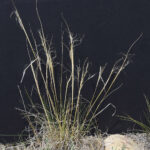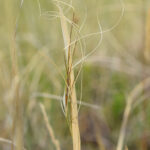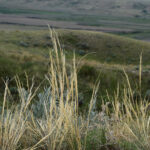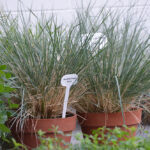Needle-and-Thread Grass
Hesperostipa comata
General Description
Needle-and-thread grass is a native bunchgrass commonly identified by its long, twisted and curly seed awns. Leaves are narrow and 5-30 cm long – although shorter basal growth is common. Needle-and-thread grass is found throughout the prairies in many native plant communities.
Type
Native grass.
Origin
Mixed grass prairie.
Longevity
Long-lived.
Use
Reclamation, pasture.
Optimal Time of Use
Graze needle-and-thread grass prior to seed set or after seed drop to avoid hard, awned seeds.
Recovery After Use
One year of rest is recommended after defoliation. In native rangelands needle-and-thread grass is an increaser species on moist sites and a decreaser species on dry sites.
Palatability/Nutritional Value
Needle-and-thread grass has an average digestibility of 40-50% and crude protein level of 6-10% during the grazing season. Palatability is reduced while seeds are present, but cures well for fall use.
Annual Precipitation min/max (mm)
127mm / 508mm
Drought Tolerance
High drought tolerance. Often goes dormant mid-summer.
Flooding Tolerance
Needle-and-thread grass withstands saturated soils for approximately one week in the spring.
Winter Hardiness
Excellent winter hardiness.
Soil Texture Preference
Needle-and-thread grass is suited to coarse sandy to loamy soils. It grows best on dry, well drained sites.
Erosion Control
May be used in a native mix but generally not used specifically for erosion control.
Salinity Tolerance
Not tolerant to salinity.
Acidity Tolerance
Slight tolerance. Needle-and-thread tolerates soil pH as low as 6.6.
Alkalinity Tolerance
Moderate tolerance.
Seeds per kg
304,000 seeds/kg (138,000 seeds/lb)
Suggested Mixtures
Mainly used for reclamation in a native species mix with species such as western wheatgrass, northern wheatgrass, Junegrass, and blue grama.
Ease of Establishment
Needle-and-thread grass seedlings have low vigour. Two or more years may be required for full establishment.
Competitiveness
Needle-and-thread grass is a fair competitor once established.
Management Considerations
Ensure adequate rest following defoliation. Sharp awns on seeds can deter grazing until after seed drop.
Saskatchewan Dryland Forage Species Adaptation Tool, AAFC Field Guide to Selected Native Forages, USDA Plants Database
Needle-and-thread grass is typically found only in the southern part of the Central Interior region in grassland communities in the Bunchgrass and Interior Douglas-fir zones. There are differences in the adaptibility of this species in different regions, and therefore seed sourced from similar ecoregions will likely perform better. For example, seed with origins in BC, Idaho or Washington will likely perform better than seed sourced from the Great Plains or the Prairies.
Needle-and-thread grass is common in the Southern Interior grassland communities in the Bunchgrass, Ponderosa pine and Interior Douglas-fir zones. There are differences in the adaptibility of this species in different regions, and therefore seed sourced from similar ecoregions will likely perform better. For example, seed with origins in BC, Idaho or Washington will likely perform better than seed sourced from the Great Plains or the Prairies.



